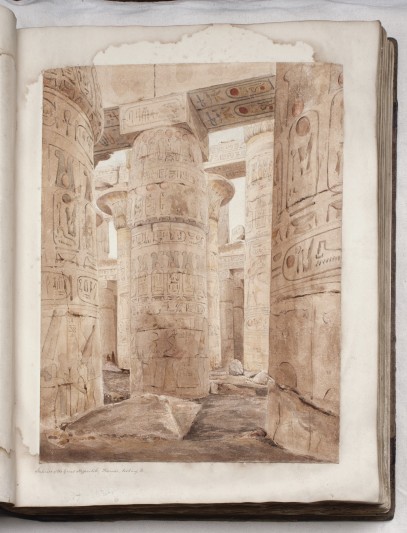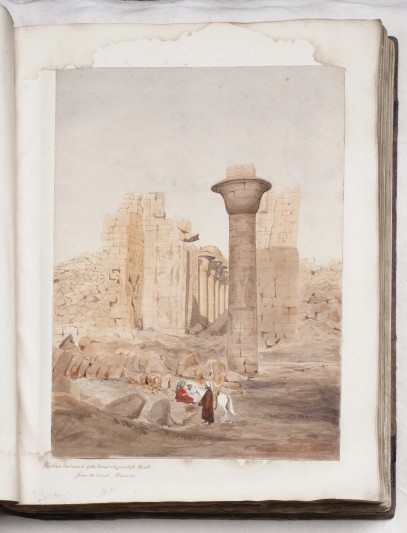‘Sold to the Griffith Institute!’: on 9 May 2017 the Griffith Institute acquired at auction at Sotheby’ an album of watercolours, drawings and tracings of Egypt by George Lloyd. This was only possible thanks to a generous grant from the Friends of the National Libraries, who previously supported our institution in acquiring Minnie Burton’s diary.
George Lloyd (1815-1843) was a British botanist, excavator and traveller. He was probably born in India on 17 October 1815, the illegitimate son of Sir William Lloyd of Brynestyn, a Welsh soldier and pioneer mountaineer, and an Indian lady. Lloyd was a member of the Cairo Literary Society and excavated at Thebes with Émile Prisse d’Avennes between 1839 and 1843. He died aged 27 in an accident at Qurna on 10 October 1843. His papers and botanical collections were given to the Botanical Garden of Montpellier.
The album was produced close to the end of Lloyd’s life (c. 1842-1843). It is a folio volume (428 x 318mm), containing 135 watercolours and drawings (74 of which are full-page and one folding) and ten tracings (eight folding). They are all mounted and most are captioned in pencil either on the image itself or on the mount. The album also contains a loose lithographed portrait of George Lloyd in Arab dress by Prisse d’Avennes, who published it in his Oriental Album: Characters, Costumes and Modes of Life in the Valley of the Nile (1848). One of the drawings in the album is a pencil portrait of Lloyd sketched by Prince Alexis Soltykoff.
The acquisition of the album is the first step in a wider project which aims to preserve, catalogue and make it entirely available on the Institute’s online catalogue. Lloyd’s album will be placed alongside other artwork collections essential for our understanding of early Egyptology, such as those by Joseph Bonomi (1796-1878), Hector Horeau (1801-1872), and Amelia Ann Blanford Edwards (1856-1891).
So far the album has been fully digitised by the Griffith Institute’s Digital Imaging Officer Mrs Jenni Navratil, and some conservation measures will be undertaken to stabilise the item in order to ensure its long term preservation, following the directions of Ms Alexandra Greathead, head of the Paper Conservation Department in the Ashmolean Museum, who assessed the diary and produced a conservation report upon the item’s arrival. The Griffith Institute has also approached a small group of its regular volunteers to assist in the cataloguing work.
The Griffith Institute staff would like to express their gratitude to the Friends of the National Libraries for once again making possible the acquisition of a precious and rare document for the Archive.


